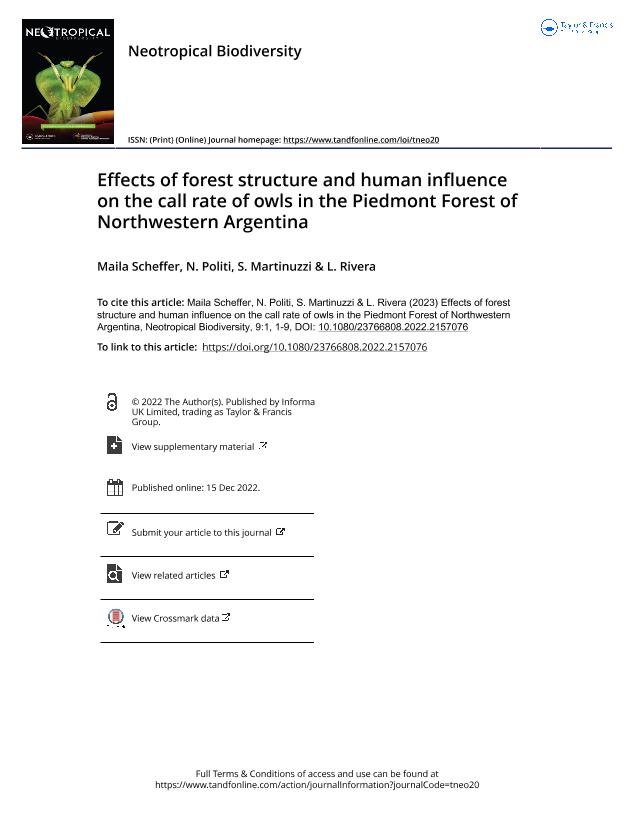Artículo
Effects of forest structure and human influence on the call rate of owls in the Piedmont Forest of Northwestern Argentina
Fecha de publicación:
12/2022
Editorial:
Taylor & Francis Ltd
Revista:
Neotropical Biodiversity
e-ISSN:
2376-6808
Idioma:
Inglés
Tipo de recurso:
Artículo publicado
Clasificación temática:
Resumen
Owls (Strigiformes) play an important ecological role as predators that structure and organize biological communities. Specialized owl species dependent on old-growth forests have suffered declines because of forest loss or degradation by human activities. Few studies have been conducted on Neotropical owls, especially in the Piedmont Forest of Northwestern Argentina. The scarcity of information on habitat requirements and the effect of human impacts preclude the establishment of conservation and management activities. The human footprint index (HFI) is a tool for mapping human impacts on biodiversity that is used at global and regional scales, based on the estimated and standardized contribution of different human impact variables (e.g. road networks, urban centers, agricultural land, etc.). The objectives of this work were to: 1) Determine the call rate of five owl species in the Piedmont Forest of Northwestern Argentina, 2) relate forest structure to the call rate of owl species, and 3) relate human footprint index to the call rate of owls. We placed 28 automatic recorders in the Piedmont Forest, in sites with low and high Human influence, and characterized the forest structure around each recorder within a circular plot of 25 m diameter. We obtained 241 vocalizations in 168 intervals of 2 h for Ferruginous pygmy owl (Glaucidium brasilianum), Tropical screech-owl (Megascops choliba), Black-banded owl (Ciccaba huhula), Spectacled owl (Pulsatrix perspicillata), and Buff-fronted owl (Aegolius harrisii). We found that for Tropical screech-owl live tree basal area had a positive and diameter at breast height standard deviation had a negative influence on call rate. While for Black-banded owl, the dead tree density had a positive and human footprint index >1 had a negative influence on call rate. For Spectacled owl, dead tree density and human footprint index >1 had a negative influence on call rate. We provide first insights into the effects of forest structure and human influence on the call rate of owls in the Piedmont Forest of Northwestern Argentina, information that may guide forest management guidelines and conservation strategies.
Palabras clave:
OWLS
,
ACOUSTIC MONITORING
,
VOCALIZATIONS
,
HUMAN FOOTPRINT
,
FOREST STRUCTURE
Archivos asociados
Licencia
Identificadores
Colecciones
Articulos(INECOA)
Articulos de INSTITUTO DE ECORREGIONES ANDINAS
Articulos de INSTITUTO DE ECORREGIONES ANDINAS
Citación
Scheffer, Maila; Politi, Natalia; Martinuzzi, Sebastián; Rivera, Luis Osvaldo; Effects of forest structure and human influence on the call rate of owls in the Piedmont Forest of Northwestern Argentina; Taylor & Francis Ltd; Neotropical Biodiversity; 9; 1; 12-2022; 1-9
Compartir
Altmétricas




